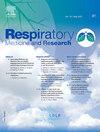长效毒蕈碱拮抗剂(LAMA)治疗哮喘:最佳策略是什么?
IF 1.8
4区 医学
Q3 RESPIRATORY SYSTEM
引用次数: 0
摘要
长效毒蕈碱拮抗剂(LAMA)的作用机制和与吸入皮质类固醇±长效β激动剂的药物协同作用的证据支持其在哮喘中的应用。这篇综述讨论了在哮喘治疗策略中使用LAMA的科学依据、临床数据和建议。在吸入皮质类固醇和长效β激动剂的双重治疗中加入LAMA已被证明可减少恶化,增加哮喘控制,改善生活质量,并具有良好的安全性。此外,使用含有多种药物的单一吸入器装置可以提高患者对治疗的依从性。文献中提出了三联疗法疗效的一些预测因素:据报道,与没有这些特征的患者相比,过去12个月内至少有一次急性发作史的患者、男性患者、年龄小于65岁的患者和非吸烟者的1秒用力呼气量(FEV1)基线改善更大,而支气管高反应性和持续性气道受限(PAL)患者的急性发作率似乎有更好的改善。然而,嗜酸性粒细胞水平似乎不能预测LAMA的疗效。LAMA联合生物治疗在严重哮喘中的作用和长期益处仍不确定,需要更多的临床数据。本文章由计算机程序翻译,如有差异,请以英文原文为准。
Long-acting muscarinic antagonists (LAMA) in asthma: What is the best strategy?
The use of long-acting muscarinic antagonists (LAMA) in asthma is supported by their mechanism of action and evidence of drug synergy with inhaled corticosteroids ± long-acting β-agonists. This review discusses the scientific rationale, clinical data, and recommendations for the use of LAMA in the asthma therapeutic strategy. Adding a LAMA to a dual therapy with an inhaled corticosteroid and long-acting β-agonist has been shown to reduce exacerbations, increase asthma control, and improve quality of life, with a good safety profile. In addition, using a single inhaler device containing multiple drugs enhances patients’ adherence to therapy. Some predictive factors of the efficacy of this triple therapy have been suggested in the literature: patients with a history of at least one exacerbation within the past 12 months, male patients, those younger than 65 years, and non-smokers have been reported to have a greater improvement from baseline forced expiratory volume in 1 second (FEV1) compared with patients without these characteristics, while patients with high bronchial hyperresponsiveness and persistent airway limitations (PAL) seem to show better gains in the exacerbation rate. However, eosinophil levels do not seem to predict the efficacy of LAMA. The role and long-term benefits of LAMA combined with biologic therapy in severe asthma remain uncertain, with more clinical data needed.
求助全文
通过发布文献求助,成功后即可免费获取论文全文。
去求助
来源期刊

Respiratory Medicine and Research
RESPIRATORY SYSTEM-
CiteScore
2.70
自引率
0.00%
发文量
82
审稿时长
50 days
 求助内容:
求助内容: 应助结果提醒方式:
应助结果提醒方式:


